
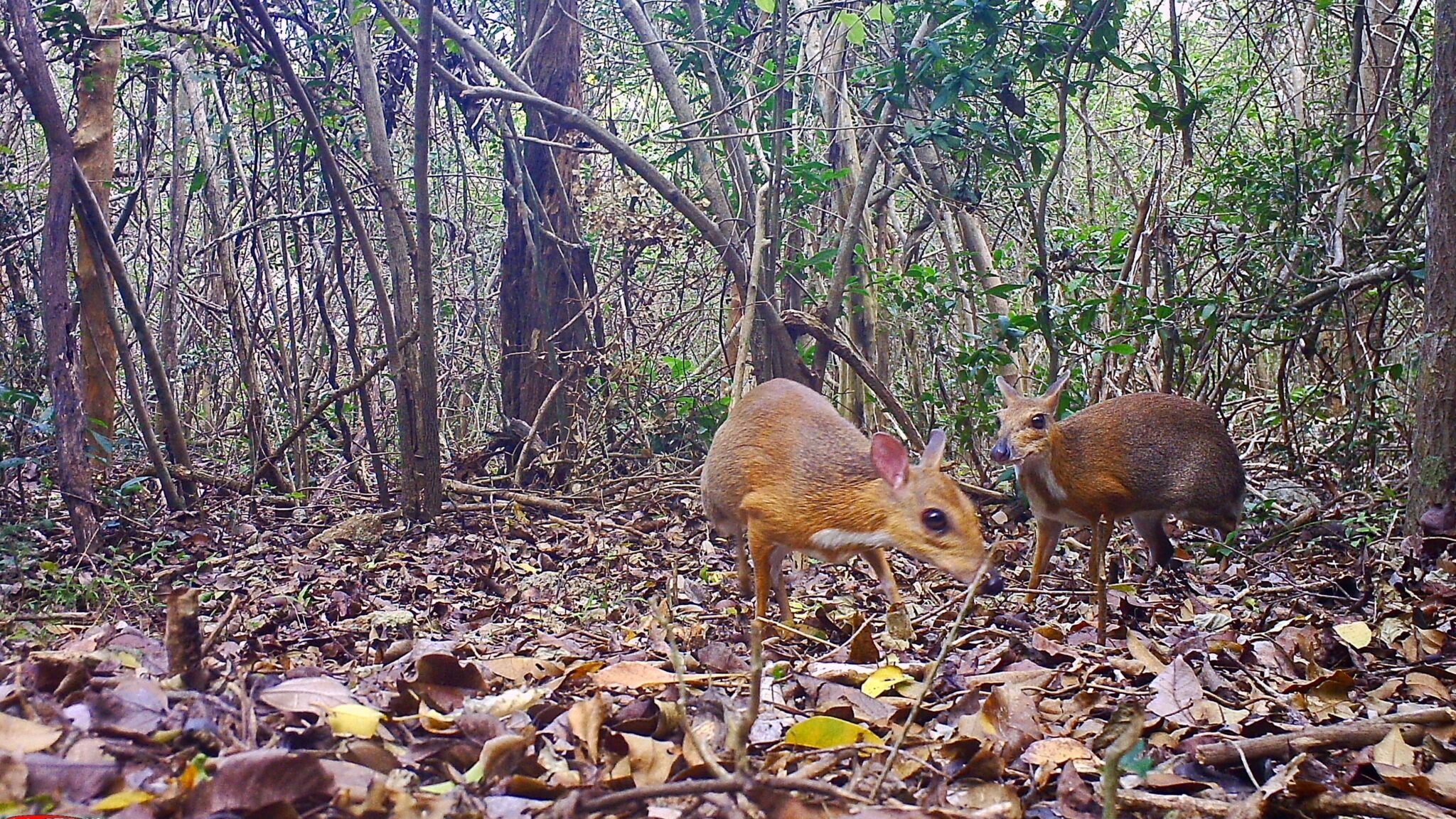
Two silver-backed chevrotain caught on camera trap. The species has only recently been rediscovered after being last seen in 1990. GWC / Mongabay
By Jeremy Hance
VIETNAM, July 2019 – I’m chasing a ghost, I think not for the first time, as night falls and I gather up my gear in a hotel in a village in southern Vietnam. I pack my camera, a bottle of water, and a poncho; outside the window I can see a light rain.
I’m here to report on the silver-backed chevrotain (Tragulus versicolor), a so-called mouse-deer that’s been missing in action (at least from science) for nearly 30 years.
My phone goes off. It’s a WhatsApp message from Anh The Nguyen, my wildlife guide on this venture. It’s time: the chevrotain is nocturnal, meaning our best chance to see one is at night. To help us, Nguyen has hired two local hunters from the Raglai ethnic group. They know the territory and they know the animal.
We take two motorbikes from the village to the forest, but barely make it a few blocks before taking shelter under an aluminum overhang as the rain, drowsy until now, becomes a full-blown tropical downpour. It thunks against the metal and the night sky growls with thunder.
Long forgotten by scientists, two years ago, the silver-backed chevrotain, also known as the Vietnam mouse-deer, gained prominence as one of the “25 Most Wanted” in the Search for Lost Species Initiative by Global Wildlife Conservation (GWC).
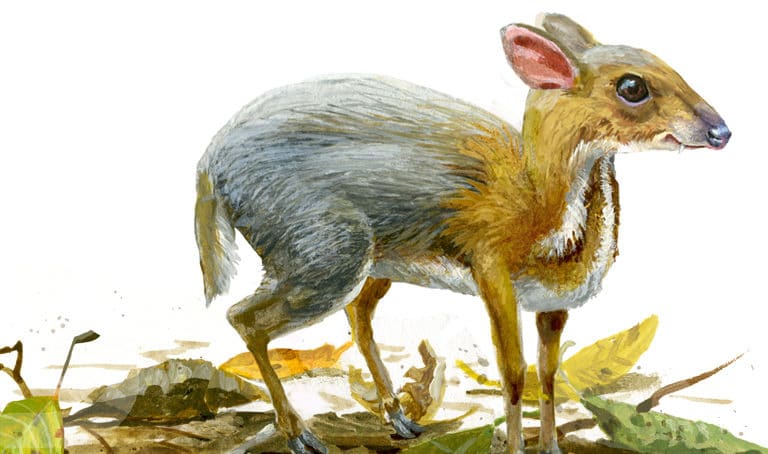
Illustration of a silver-backed chevroatin. Eric Losh / Mongabay
“That’s when we first put together a plan of action,” said Andrew Tilker, the Asian species officer for GWC, who described a 2017 meeting in Hanoi with a who’s who of Vietnamese mammal conservation that ended with a planned expedition to see if the species persisted.
The search, focusing on camera trapping, would be headed by An Nguyen, an associate conservation scientist for GWC as well as a field coordinator and Ph.D. student with Germany’s Leibniz Institute for Zoo and Wildlife Research. The endeavor would partner GWC with both the Leibniz Institute and Vietnam’s Southern Institute of Ecology.
By the time I show up in Vietnam at the end of July this year, the search has already succeeded — but the announcement is still months away from being made public. Searching one primary location, Nguyen and his colleagues were able to get more than 2,000 photos of the silver-backed chevrotain, a mammal many feared extinct. And they did it not far from the little hotel where I’m staying.
Still, even as the scientists rediscovered the species, none of them had seen it in the flesh. I was here to hopefully do that — and if not, at least get a firsthand sense of the story behind this animal’s re-emergence and its chances for long-term survival. I mean, the animal had lived wholly under the radar for nearly 30 years; how hard could it be for a journalist to spot in just two days?
Light appears as one of the men from the Raglai ethnic group ignites a cigarette. Nguyen, the guide, chats with them in Vietnamese. One of the Raglai men, I’ll call him Chi, looks to be in his late forties; he’s grizzled but has a wide, friendly smile. The other, Xuan, is young, I’d hazard in his late teens or early twenties, and is married with a newborn. As the rain hammers above, the three men share a joke and stories of recent hunts with Nguyen. No one knows this species better than these indigenous hunters. Even as it dropped off scientists’ radar, it was still being hunted.
We wait 20 minutes for the brunt of the storm to pass the village (we are not divulging the exact location in an effort to mitigate potential poaching). When the rain dwindles, Nguyen says, “We go now.” The older hunter, Chi, tosses his burnt-out cigarette on the ground and he and his fellow villager get on their motorbike.
I take a deep breath, jump onto the motorbike behind Nguyen, and we speed off into the night, headed to a thorny, vine-filled dry forest. The missing chevrotain is here.
Nguyen and I know it because of the camera trap photos. But our other two travelers know it with much greater physical intimacy: the younger man had hunted a silver-backed chevrotain a fortnight ago, while the older man had killed three of them just five days ago.
Lost and Found
The silver-backed chevrotain, a handsome (one could even say adorable) small ungulate, was first described in 1910, based on four specimens. No scientists recorded it again for another 80 years, but in 1990 a Russian expedition collected a fifth specimen — though that one came under some doubt.
The doubt is gone now.
“We had no idea what to expect, so I was surprised and overjoyed when we checked the camera traps and saw photographs of a mouse deer with silver flanks,” said An Nguyen, the expedition leader. “Discovering that it is, indeed, still out there, is the first step in ensuring we don’t lose it again.”
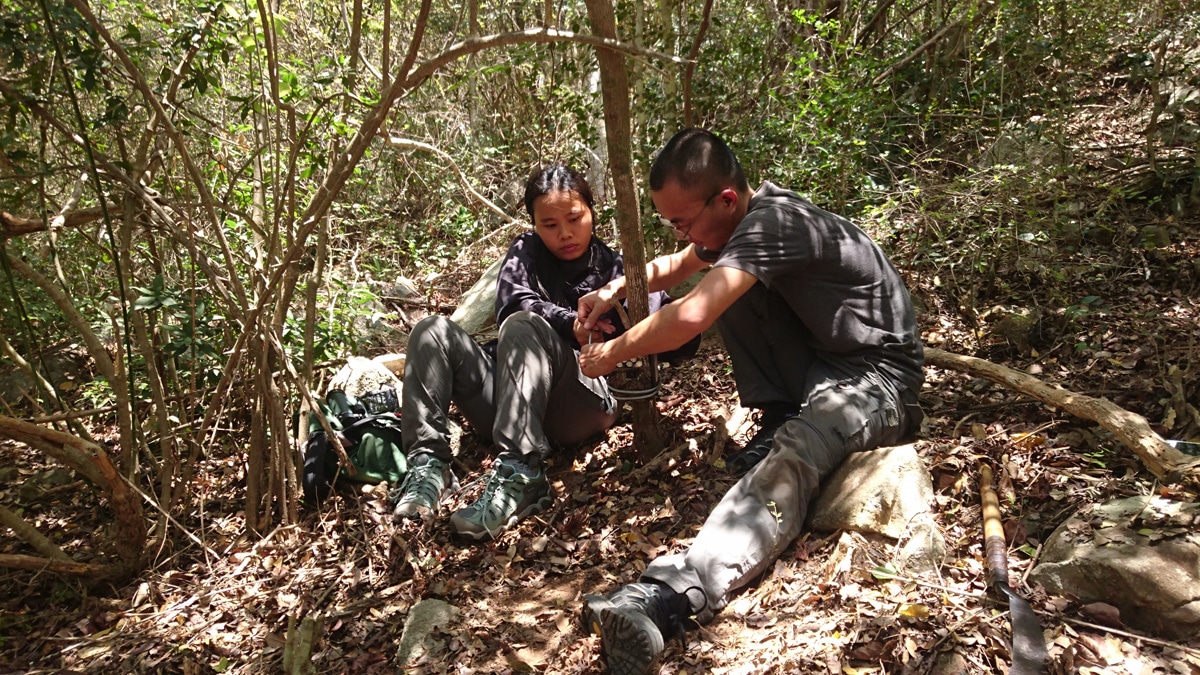
Researchers setting up the camera traps that would rediscover the silver-backed chevrotain, after missing for nearly 30 years. GWC / Mongabay
After conducting interviews with wildlife rangers and local people, Nguyen set five camera traps in a target area. They caught the first photos ever of this species, taking 275 photos of the animal over a period of five months. Nguyen came back with 29 camera traps, capturing 1,881 photos of the animal in the same area. This, of course, doesn’t mean these were all individuals — many of the photos are of the same animals. But it does mean, at least in this one small area, that the animal is relatively abundant.
This is GWC’s first success in finding one of the missing mammals in its Search for Lost Species. Four other species on the list have been discovered in the past couple of years. Twenty remain missing.
Still, rediscovery is only the beginning. The lives of silver-backed chevrotains are almost entirely a mystery. They are similar in size and looks to the far more common lesser mouse-deer (Tragulus kanchil), but have an unmistakable silver back, whereas the lesser mouse-deer are a one-tone animal.
“There are other less obvious differences,” Tilker says. “The gray hairs on the silver-backed chevrotain are tipped with white, giving the posterior a grizzled appearance. Also, the silver-backed chevrotain lacks the transverse throat stripe that is present in the lesser chevrotain.”
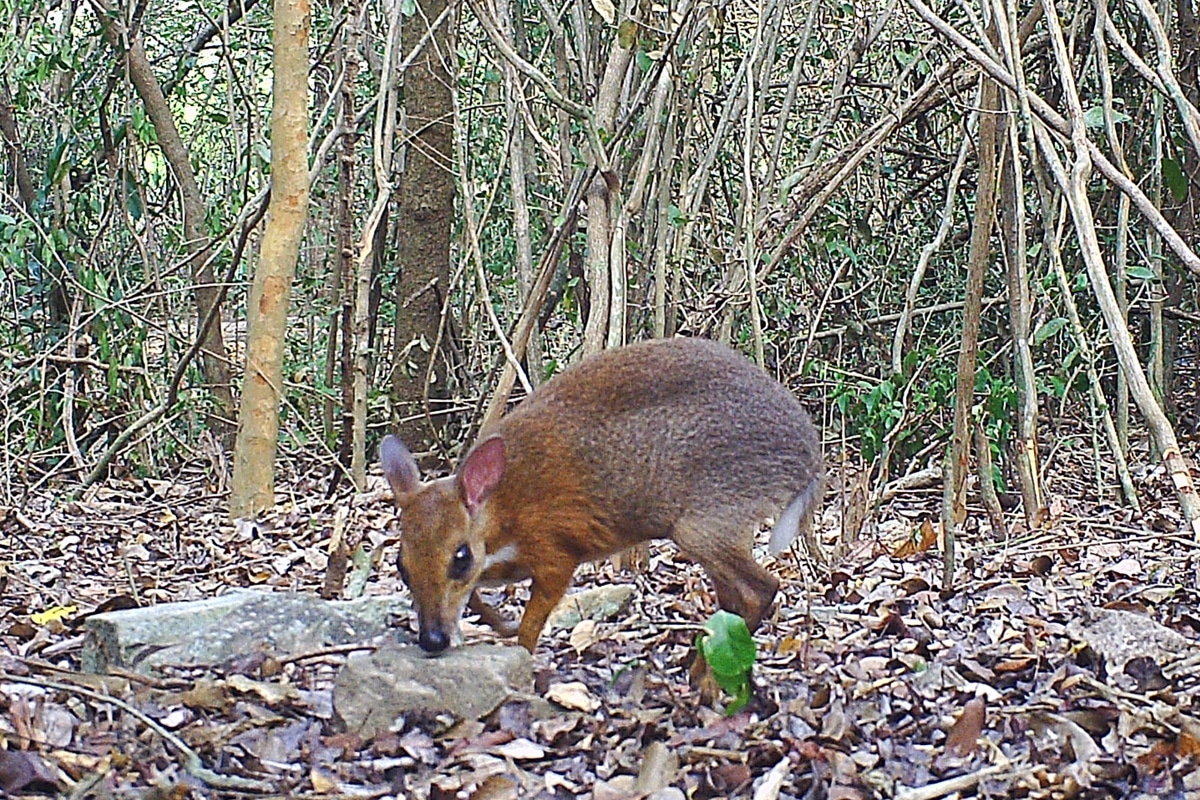
A silver-backed chevrotain on camera trap. Note the handsome silver-gray of its back. GWC / Mongabay
Chevrotains may be called mouse-deer, and they do resemble rabbit-sized “deer.” But they are not in the deer family, Cervidae. Instead they make up their own family, Tragulidae, and infraorder, Tragulina, which translates roughly into “little goat.” All the world’s chevrotains but one (the water chevrotain of Central Africa, Hyemoschus aquaticus) are found in Asia. The world’s smallest ungulates, chevrotains are actually ancient and primitive, having broken off from all other ruminants 50 million years ago. Chevrotains have surprising features like four toes, fangs, and for some, at least, the ability to stay submerged underwater for a surprisingly long time; some believe they may even represent a direct link to the kind of early mammal that eventually evolved into whales and hippos.
The silver-backed chevrotain is not only important as a unique member of this bizarre and wonderful family, but also the only chevrotain found only in Vietnam, making it an endemic, endangered species for this Southeast Asian country.
Into the (Wet) Woods
My guide, Anh The Nguyen, and the young hunter, Xuan, and I had been to this same site the night prior, scurrying through the low, dry forests, stooping below branches and vines bent in natural tunnels (if we were gnomes) or crawling along the rock and dirt as thorns tore at us. We had spent two hours in the forest, but with no luck. The silver-backed chevrotain, small, shy and wary of humans (for good reason), did not make itself known.
We hope for better luck tonight, but the recent deluge adds a new level of misery: every branch and vine is slick and dripping, while the dirt has turned into mud.
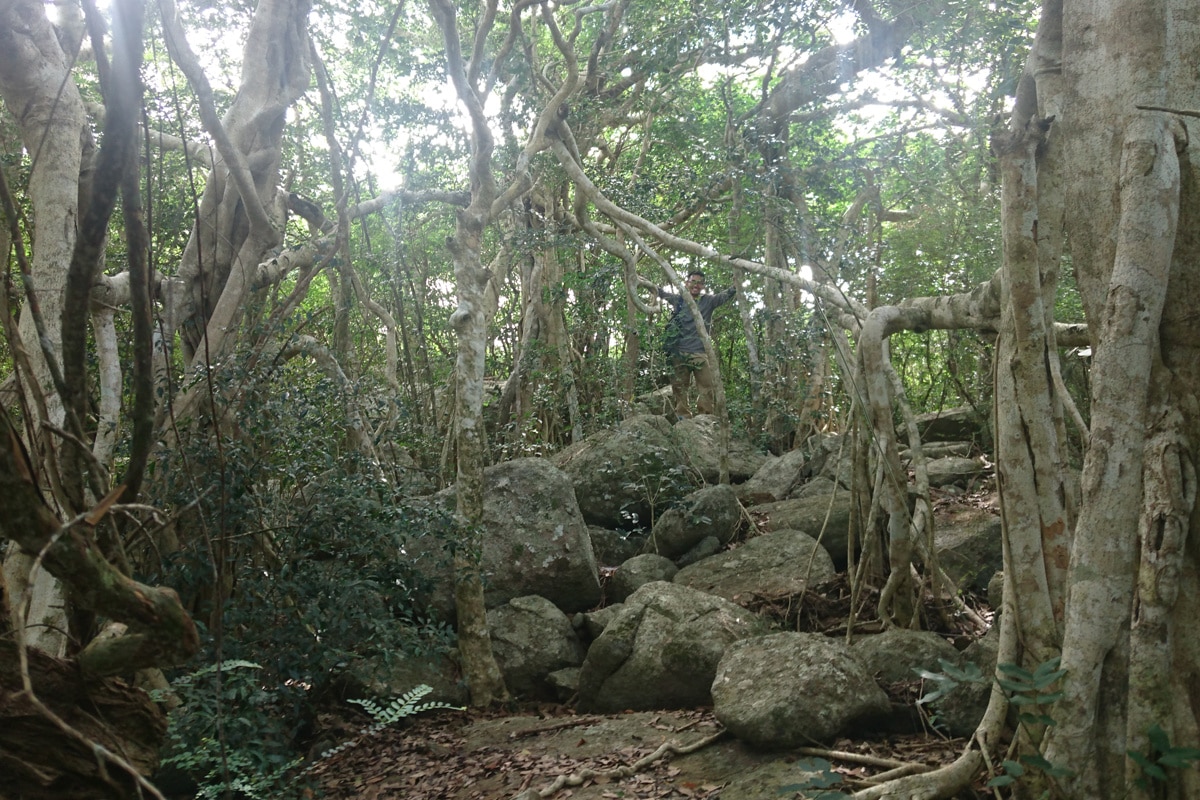
A typical habitat for the newly rediscovered silver-backed chevrotain. GWC / Mongabay
Still, we split into two groups: I go with Xuan while Nguyen shadows Chi. To keep in touch, Xuan and Chi hoot back and forth.
Within minutes, my clothes are soaked through despite the poncho. I can’t see anything more than an Impressionist painting-like view of a dark forest, thanks to my smudged, water-splattered glasses. But I feel the vines entrap me, catching across my chest like ropes, and I find myself just pushing through, shoving my way in and out of the indistinguishable branches and vines. I slip and fall, and suddenly I’m on my hands and knees, just army crawling through the mud.
Ahead of me, Xuan, whom Nguyen and I nicknamed Spiderman, floats through the forest like some ninja. I struggle to keep pace, my heart pounding, my mind a blank, my only real thought: “C’mon, Jeremy, keep up.”
Suddenly the hooting from the other team increases in tempo — that’s the signal! — and I hear the branches crack and snap as Xuan and I attempt to make our way toward the sound.
By the time we get there, though, there’s nothing to see. Chi had spotted a female chevrotain, pregnant, he thought, but she’d vanished into the ticket as the three of us tried to reach him.
As the three men chat in Vietnamese, I touch my temple to find an inch-long thorn stuck deep. I pull it out and sit back against a boulder, exhausted and trying to catch my breath.
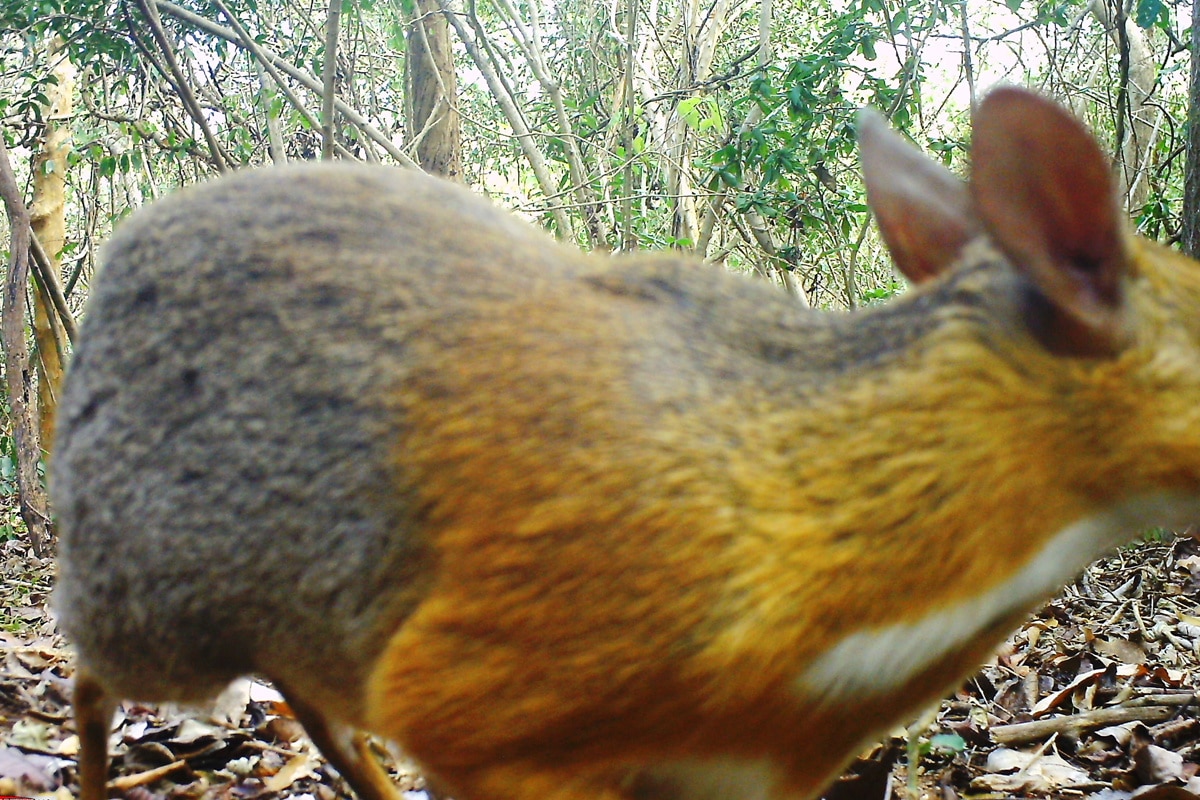
Silver-backed chevrotain close up on camera trap. GWC / Mongabay
After a few minutes, Nguyen comes over. “They say we are too loud and we scare away the chevrotain.”
“Yup,” I agree.
“They say we are so loud that our noisiness even scares them!” We both laugh.
“Time to call it then?” I ask.
“Yes I think so.”
In that moment, my feeling is less disappointment, and more relief. I knew that trying to see the animal in the flesh with two days was always a long shot. But my trip could hardly be called a failure. I’d seen the species’ natural habitat and met, at least, one of its potential threats: overhunting.
The Tail
Five days before our arrival, Chi had hunted down three silver-backed chevrotains.
A single dead chevrotain provides about 2 kilograms, about 4.5 pounds, of meat (from a 3–kilogram, or 6.6-pound animal), and he and his family had already eaten the three animals — a shame since a dead specimen would have been scientifically important.
Prior to our wet adventure, Chi and Xuan had told us how they did not hunt chevrotains with guns (guns are illegal in protected areas) but with slingshots. Chi showed me his: it was sturdy and well-crafted; I pulled back on the rubber bands and test the weapon’s tautness. Yet the skill needed to sneak up on and kill a rabbit-sized animal with one well-aimed projectile is incredibly impressive.

Illustration of Interviews with locals were key in nailing down potential locations of the missing species. Eric Losh / Mongabay
The Raglai people have been hunting chevrotain here for centuries if not millennia. The hunting of the silver-backed chevrotain and lesser mouse-deer (hunted in the rainforest) isn’t really a commercial endeavor, so far as I’d heard.
It wasn’t like the story Nyugen told me of how a few poachers with guns had managed to nearly wipe out the entire local population of doucs (Pygathrix spp.), a type of monkey, to sell in Vietnamese cities. The douc population is only now starting to recover.
Local hunters, at least the ones we met, simply hunted chevrotain to put some cheap meat on the table — though they did so illegally, given the area’s status as a protected site.
But that doesn’t mean other hunters kill only for subsistence consumption. Vietnam is home to a thriving and massive bushmeat trade where animals are killed in the forest and then trafficked to urban areas for sale.
Moreover, since scientists don’t know how many of this species may be left, any hunting, even if just for local consumption, may well be wholly unsustainable.
An even larger worry: the deepening snaring crisis across Southeast Asia, like a pestilence that hits all wildlife, could wipe out this species before scientists even have a chance to develop means for its conservation. Snares, cheap and easy, have been set in the millions and are indiscriminate killers.
To understand how imperiled the species may be, the scientific team has begun camera-trapping in two additional locations. Once they have more information, they plan to develop a much-needed conservation plan.
Nguyen, the expedition leader, says that while the team hopes to find the species in other locales, it’s quite possible these populations have “collapsed” due to hunting, snaring, and habitat loss. Time will tell.
“The work is only beginning with the rediscovery and initial protection measures that have been put in place,” said Barney Long, GWC senior director of species conservation. “Now we need to identify not just a few individuals on camera trap, but one or two sites with sizable populations so that we can actually protect and restore the species.”
Even though Chi and his family have eaten the rewards of his recent illegal hunt, he did keep the tail of one of his quarries. He’d dried it out and planned to use it as a decoration for his motorbike key chain.
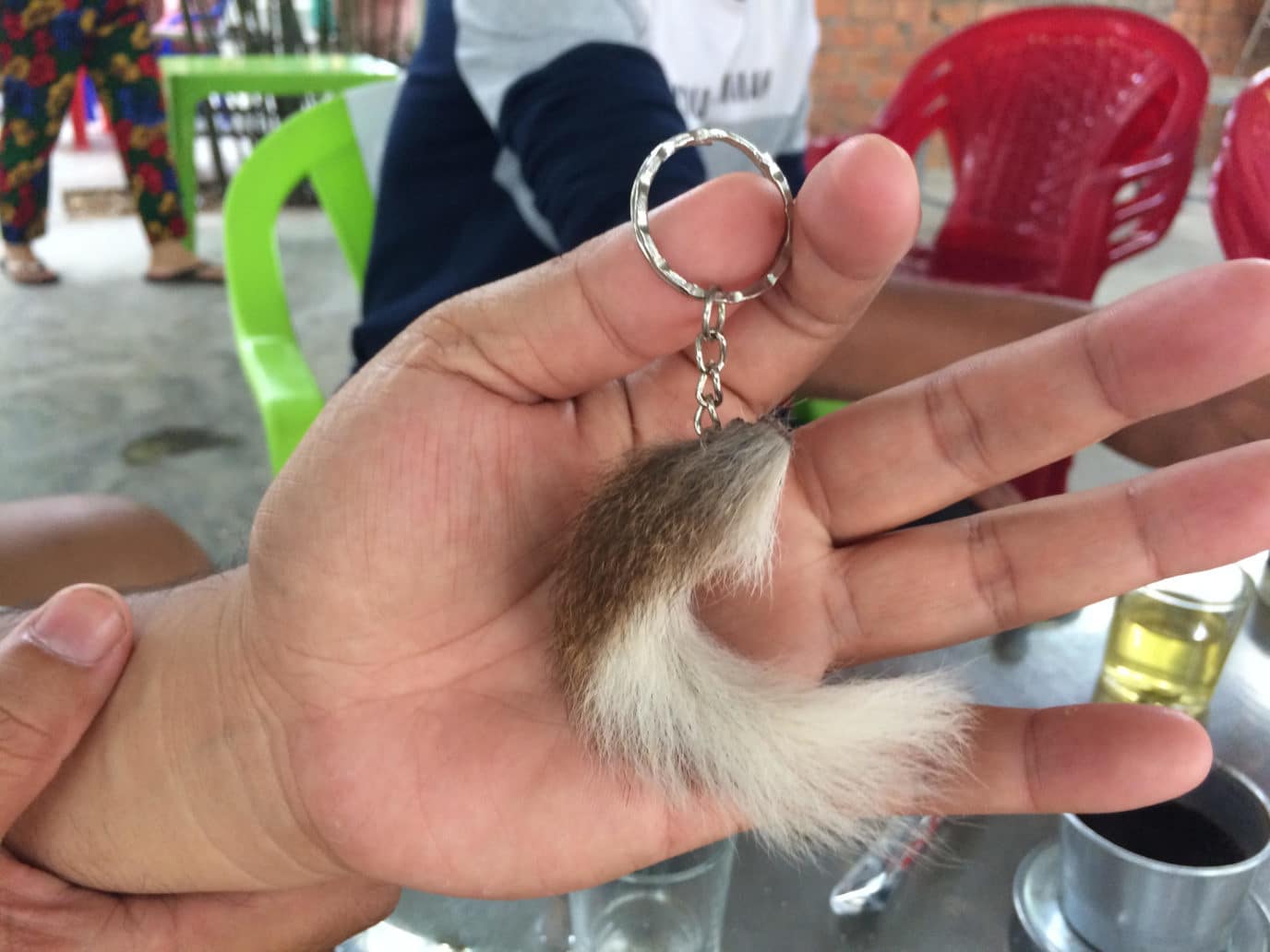
The tail of a recently hunted silver-backed chevrotain. Scientists will conduct genetic analysis on the tail. Jeremy Hance / Mongabay
We ask if we can buy it from him.
The next morning Nguyen and I meet Xuan over coffee in town. As the coffee drips into the cup, in the traditional Vietnamese style, Xuan hands us the tail of the recently slaughtered silver-backed chevrotain. Brown and silver hairs kick out of the top while the bottom is white; the nub is still wet.
Two days later, I pass the tail off to researchers in Hanoi who will get it to An Nguyen, for genetic analysis. Before I do, though, I hold it in my hand for one moment longer, the softness of the tail the closest I physically get to the silver-backed chevrotain.
Still a ghost, I think, but one that has managed against all odds to hang on.
Reposted with permission from Mongabay.
- Nearly 30,000 Species Face Extinction Because of Human Activity ...
- Invasive Species Have Led to a Third of Animal Extinctions Since 1500
- Leaked Trump Administration Memo: Keep Public in Dark About ...

 233k
233k  41k
41k  Subscribe
Subscribe 